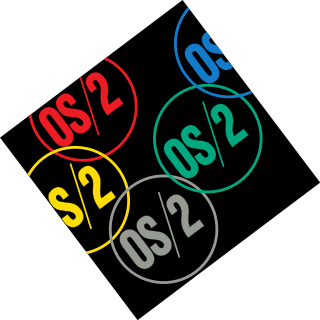
OS/2 is a series of computer operating systems, initially created by Microsoft and IBM under the leadership of IBM software designer Ed Iacobucci. As a result of a feud between the two companies over how to position OS/2 relative to Microsoft's new Windows 3.1 operating environment, the two companies severed the relationship in 1992 and OS/2 development fell to IBM exclusively. The name stands for "Operating System/2", because it was introduced as part of the same generation change release as IBM's "Personal System/2 (PS/2)" line of second-generation personal computers. The first version of OS/2 was released in December 1987 and newer versions were released until December 2001.
Samba is a free software re-implementation of the SMB networking protocol, and was originally developed by Andrew Tridgell. Samba provides file and print services for various Microsoft Windows clients and can integrate with a Microsoft Windows Server domain, either as a Domain Controller (DC) or as a domain member. As of version 4, it supports Active Directory and Microsoft Windows NT domains.

StarOffice is a discontinued proprietary office suite. Its source code continues today in derived open-source office suites Collabora Online and LibreOffice. StarOffice supported the OpenOffice.org XML file format, as well as the OpenDocument standard, and could generate PDF and Flash formats. It included templates, a macro recorder, and a software development kit (SDK).

SmartSuite is a discontinued office suite from Lotus Software. The company made versions of its office suite for IBM OS/2 and Microsoft Windows.

The IBM ThinkPad 701 is a subnotebook in the ThinkPad line by IBM. The 701 is colloquially known as the Butterfly due to its sliding keyboard, which was designed by John Karidis. It was developed from 1993 and sold from March 1995 until later that year and priced between $1,499 and $3,299. The 701 was the most sold laptop in 1995 and has received 27 design awards. It was based on either the DX2 or the DX4 version of the Intel i486, combined with CT-65545 graphics chip from Chips and Technologies. The 701Cs version used a DSTN display, while the 701C used a TFT LCD. It was pre-installed with Windows 3.11 and for the DX4 models also with OS/2 Warp 3.0. The 701 was discontinued because the keyboard design was no longer a necessity after screen sizes increased. After its discontinuation there has been some speculation about a new notebook with a butterfly style keyboard.

Multi-booting is the act of installing multiple operating systems on a single computer, and being able to choose which one to boot. The term dual-booting refers to the common configuration of specifically two operating systems. Multi-booting may require a custom boot loader.

DOSKEY is a command for DOS, IBM OS/2, Microsoft Windows, and ReactOS that adds command history, macro functionality, and improved editing features to the command-line interpreters COMMAND.COM and cmd.exe.
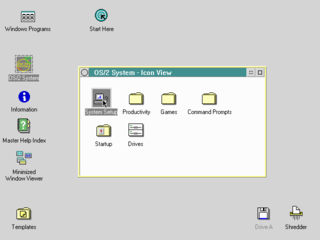
The Workplace Shell (WPS) is an object-oriented desktop shell produced by IBM's Boca Raton development lab for OS/2 2.0. It is based on Common User Access and made a radical shift away from the Program Manager type interface that earlier versions of OS/2 shared with Windows 3.x or the application-oriented WIMP interface of the Apple Macintosh. The Workplace Shell was also used in OS/2 Warp 3 and Warp 4, and the OS/2-based operating systems eComStation and ArcaOS.

Program Manager is the shell of Windows 3.x and Windows NT 3.x operating systems. This shell exposed a task-oriented graphical user interface (GUI), consisting of icons arranged into program groups. It replaced MS-DOS Executive, a file manager, as the default Windows shell.
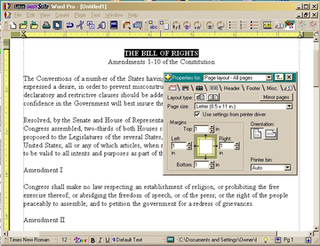
Lotus Word Pro is a word processor produced by IBM's Lotus Software group for use on Microsoft Windows-compatible computers and on IBM OS/2 Warp. Word Pro was available as part of the Lotus SmartSuite office suite.
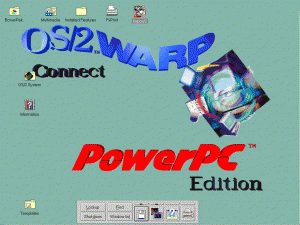
Workplace OS is IBM's ultimate operating system prototype of the 1990s. It is the product of an exploratory research program in 1991 which yielded a design called the Grand Unifying Theory of Systems (GUTS), proposing to unify the world's systems as generalized personalities cohabitating concurrently upon a universally sophisticated platform of object-oriented frameworks upon one microkernel. Developed in collaboration with Taligent and its Pink operating system imported from Apple via the AIM alliance, the ambitious Workplace OS was intended to improve software portability and maintenance costs by aggressively recruiting all operating system vendors to convert their products into Workplace OS personalities. In 1995, IBM reported that "Nearly 20 corporations, universities, and research institutes worldwide have licensed the microkernel, laying the foundation for a completely open microkernel standard." At the core of IBM's new unified strategic direction for the entire company, the project was intended also as a bellwether toward PowerPC hardware platforms, to compete with the Wintel duopoly.

IBM WebExplorer was an early web browser designed at IBM facilities in the Research Triangle Park for OS/2.
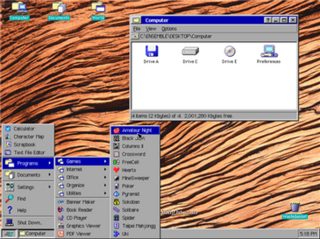
GEOS is a computer operating environment, graphical user interface (GUI), and suite of application software. Originally released as PC/GEOS, it runs on DOS-based, IBM PC compatible computers. Versions for some handheld platforms were also released and licensed to some companies.

The Object REXX programming language is a general-purpose object-oriented scripting language.

eComStation or eCS is an operating system based on OS/2 Warp for the 32-bit x86 architecture. It was originally developed by Serenity Systems and Mensys BV under license from IBM. It includes additional applications, and support for new hardware which were not present in OS/2 Warp. It is intended to allow OS/2 applications to run on modern hardware, and is used by a number of large organizations for this purpose. By 2014, approximately thirty to forty thousand licenses of eComStation had been sold.

Lotus Freelance Graphics is an information graphics and presentation program developed by Lotus Software following its acquisition of Graphic Communications Inc in 1986. It was first released for DOS and OS/2 operating systems, then later released as part of the Lotus SmartSuite for Microsoft Windows.

Apache OpenOffice (AOO) is an open-source office productivity software suite. It is one of the successor projects of OpenOffice.org and the designated successor of IBM Lotus Symphony. It was a close cousin of LibreOffice, Collabora Online and NeoOffice in 2014. It contains a word processor (Writer), a spreadsheet (Calc), a presentation application (Impress), a drawing application (Draw), a formula editor (Math), and a database management application (Base).

ArcaOS is an operating system based on OS/2, developed and marketed by Arca Noae, LLC under license from IBM. It was codenamed Blue Lion during its development. It builds on OS/2 Warp 4.52 by adding support for new hardware, fixing defects and limitations in the operating system, and by including new applications and tools, and includes some Linux/Unix tool compatibility. It is targeted at professional users who need to run their OS/2 applications on new hardware, as well as personal users of OS/2.

Microsoft Office 2019 is a version of Microsoft Office for both Windows and Mac. It replaces Office 2016 and was replaced by Office 2021 on October 5, 2021. It was unveiled on April 27, 2018, for Windows 10 and June 12, 2018, for macOS, and launched on September 24, 2018. Some features that had previously been restricted to Office 365 subscribers are available in this release. Office 2019 remain same major version 16 as predecessor Office 2016, therefore it is second perpetual release of Office 16. Microsoft plans to end mainstream support for Office 2019 on October 10, 2023. Unlike other versions of Microsoft Office, Office 2019 will only get two years of extended support, which means that support for Office 2019 will end on the same day as support for Office 2016 and Windows 10, on October 14, 2025.















